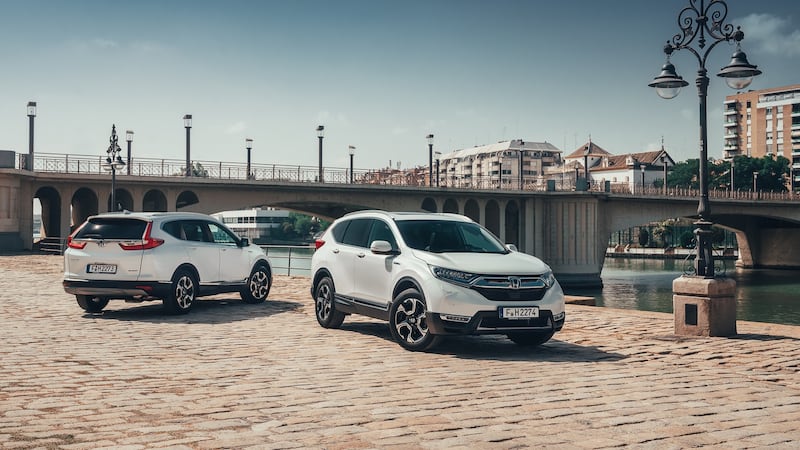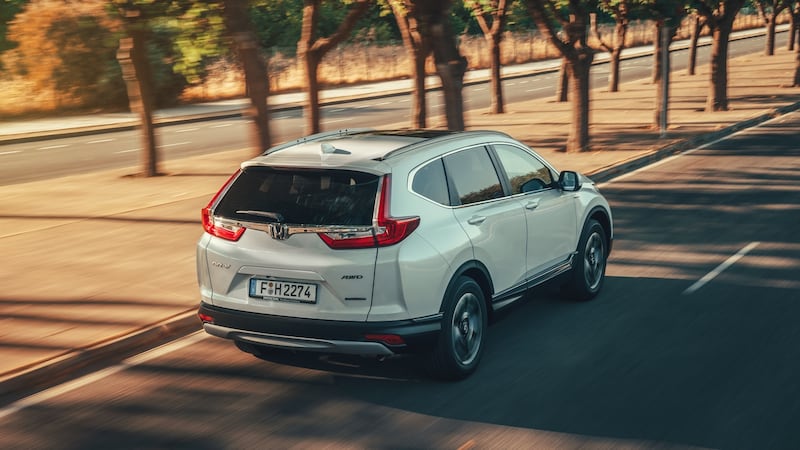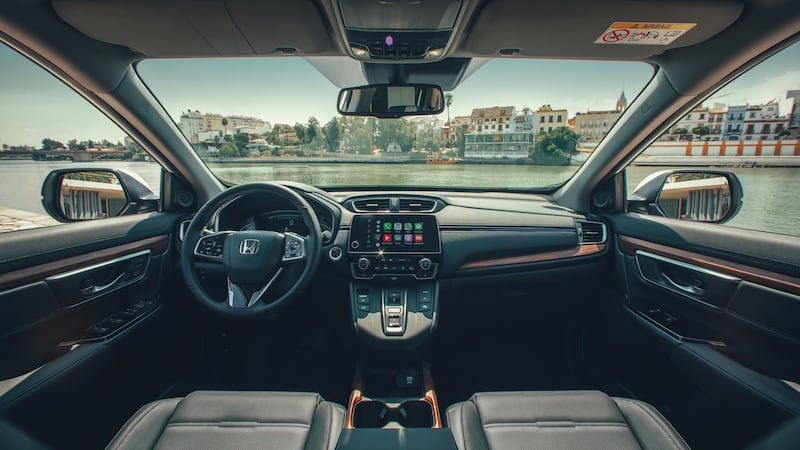Honda caused a bit of a stir when it launched the fifth generation CRV in petrol only form only. Well, a global stir, for the Japanese crossover has never really caused more than a ripple on the Irish motoring market.
The mid sized SUV may be a massive global success and with over 9.2m sales is entitle to claim the title of the world's favourite crossover. In Ireland, however, the CR-V is a niche player and the decision to ditch a diesel option would seem akin to commercial suicide for the model range.
Thankfully the Japanese firm is offering an alternative: a hybrid that should catch the wave of interest in such formats created by its bigger Asian rival Toyota.
The new CR-V’s 1.5 litre petrol engine taken from the Civic is available in two power outputs of 173hp and 193hp in the Auto AWD guise. The turbocharged 1.5 does a good job of hauling the five or seven seat versions around but is still a little shy on pulling power.
This is where the new CR-V hybrid steps in to fill the power gap.
Honda has history with hybrid: in fact its Insight predates the better-known Prius, which stole the public attention for such formats at the turn of the century.
Since the Insight arrived in 1999, the Civic, CR-Z and Jazz hybrids were added. The CR-V hybrid is the Japanese brand’s first European hybrid SUV. Two and four wheel drive versions will be available when the car goes on sale in Ireland next February.

The stock CR-V produces a maximum of 243nm while the new CR-V Hybrid pushes out 315nm that nicely fills the power gap. Fuel consumption is dramatically better with the hybrid falling from 7.1 litres per 100 kilometres to 5.3 l/100km. The CR-V Hybrid driving experience features Honda’s new intelligent multi-mode drive (iMMD) technology that works away in near silence and automatically selects from electric only, hybrid (electric motor and petrol engine) or engine only driving profiles.
The CR-V Hybrid uses a combination of a petrol-powered internal combustion engine, an electric motor, an electric generator motor and a rechargeable lithium-ion battery pack to power the wheels. It also uses regenerative braking to top up the battery pack. The new i-VTEC 2-litre petrol engine has been tuned to be highly efficient. Most hybrid cars use what’s known as a planetary CVT automatic gearbox that are often criticised despite the engineering efficiency for being whiney. Unlike other hybrids the CR-V Hybrid has just one fixed gear.

EV mode
The Honda CR-V’s hybrid system is innovative. In EV Drive mode the rechargeable battery pack provides power to the electric propulsion motor that turns the wheels. In Hybrid Drive the wheels are turned by the electric propulsion motor. In this case it gets power from two sources, the battery pack and an electrical generator - that in turn is powered by the petrol engine. The only time the petrol engine drives the CR-V Hybrid’s wheels directly is in the aptly named Engine Drive mode.
Engine Drive is most efficient at speeds of between 120-140km/h. The CR-V Hybrid’s top speed is attained in hybrid mode. Honda has linked via a clutch the engine and propulsion electric motor so that every moving component that needs to be connected is.
Under the bonnet is the petrol engine, propulsion motor, generator motor and power control unit. The rechargeable lithium-ion battery pack is housed under the rear bench and this position rules out a seven seat hybrid version. In the spacious cabin that is built on the new Civic’s platform, the driver just needs to press a button to select drive and not pull a lever as in with the 1.5’s CVT auto box. A press on the accelerator and off you go.
If the batteries are not getting topped up enough from regenerative braking the engine sends power to the generator to boost the pack. The driver can put some input into how the car is propelled with a sport button that sharpens artificially the throttle response. There is an eco mode and an EV mode button that prioritises electric only motion.
The EV electric button works with a light right foot and will use the battery until it’s out of charge. The electric only range is laughable at just 2km. The Honda system is best left to its own devices as it shuffles between modes depending on workload. At 60 km/h the power is roughly 50/50 between engine and battery. At 100 km/the Atkinson-cycle petrol engine is doing two thirds of the work and at maximum speed the car needs to be in hybrid drive. Honda has specifically tuned a rising engine note that can be heard in the cabin under acceleration and this was done to suit European tastes.
On the road
On the road the CR-V Hybrid starts up in electric mode in silence. The engine will cut in if you provoke it but it is whisper quiet compared to a diesel unit. In stop start traffic the five seater is a joy to use as it seamlessly and without fuss makes progress.
The Honda delivers a silky smooth transitions between the various driving and power modes that are barely noticeable. The big, comfortable and easy to access cabin is swept along in near silence thanks the quiet petrol engine and silent electric motor but also Honda’s new noise cancelling technology that works in a similar way to other systems via the cars speakers.

The Hybrid is a great cruiser that eats up distances. The hybrid gets a new drivers instrument interface display and all the other toys available in the regular CR-V like the optional HUD. The idiosyncratic Honda centre touch screen remains tricky to get your head around.
Once mastered, the CR-V goes about its business without requiring much effort from the driver. Two wheel drive versions will be the most popular but we also took the all wheel drive for a test. The all wheel drive system uses a prop shaft connecting the rear drive shafts and takes power from the engine and electric propulsion motor as with the FWD version. To aid off road use the AWD hybrid rides 10mm higher. Both our test cars featured Bridgestone Dueler SUV tyres.
Apart from the boot shrinking from 561 litres to 497 litres the only downside with the hybrid CR-V versus the petrol model is its relatively poor towing performance. The CR-V Hybrid can tow 600kgs or just 750kgs braked, so big caravans and horse boxes are out.
Prices
CR-V Hybrid prices start from €38,000 including grants. Trim levels are comfort (FWD only), lifestyle, elegance and executive AWD automatic topping the range at €49,500. The entry petrol powered 173hp CR-V has a manual gearbox so the realistic like-for-like price walk from the more powerful 193hp 1.5 automatic to CR-V hybrid is roughly €2,500. Honda Ireland expects 65 to 70 per cent of CR-V sales to be hybrid, out of a total annual sales of 500.
The diesel witch-hunt will continue with some German cities even banning relatively clean last generation Euro5 diesels. Honda says it sees a shifting demand and estimates that by 2021 diesel will account for 46 per cent of the compact SUV class with petrol at 33 per cent and alternative fuel at 21 per cent from just 6 per cent in 2018. By 2025 two thirds of Honda’s vehicles will have an electrified power train.
By the end of 2019 we will see the adorable Honda Urban EV arrive followed by the Jazz Hybrid in 2020 then the Civic Hybrid and HRV Hybrid in 2021. The CR-V Hybrid is a good family car packed with technology but yet is quite soothing to drive. Still a niche player though.
Lowdown: Honda CR-V Hybrid 2WD
Power: 184hp 0-100km/h: 8.8 seconds Top Speed: 180 km/h Claimed fuel economy: 5.3l/100km (53.3mpg) CO2 emissions: 120g/km NEDC Motor tax: €200 Verdict: Simple to use, comfortable and functional. Our rating: Three stars










